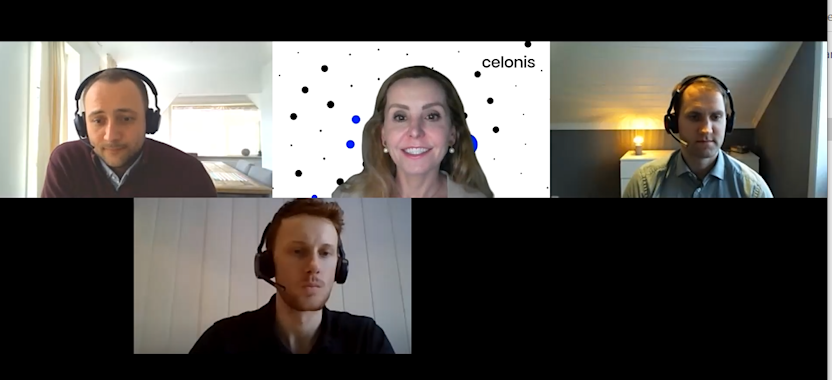
How Wilhelmsen is Innovating with Celonis and Snowflake to Shape the Maritime Industry
Recently Celonis has become a Premier partner to Snowflake to better address the needs of our joint customers. We now have a connector that makes it easy for customers to utilize the data stored in Snowflake with the Celonis Execution Management Systems (EMS) in order to identify and address process related execution gaps. I’ve had the pleasure of getting to know one of our joint customers, Wilhelmsen group, a highly innovative company that was founded in 1861, which currently operates the largest maritime network on the planet, with over 2,200 locations worldwide. The team at Wilhelmsen embarked on a journey to innovate with Snowflake and Celonis very early on, and they kindly shared some of their learnings and insights on our zoom calls. This blog is a recap of my Q&A sessions and conversations with Christian Løset (Head of Technology & Strategy, Data & Analytics at Wilhelmsen Ships Service, GBS-IT), Bart Mientjes (Process Mining Program Manager at Wilhelmsen Ships Service, Marine Products), Philipp Heinze (Senior Business Transformation Consultant at Wilhelmsen Ships Service, Marine Products) and in collaboration with Frank Fodstad (Vice President, Operations, Wilhelmsen Ships Service, Marine Products).

Looking back at your journey, can you share what initially sparked your interest in Celonis?
Our efforts to standardize processes and improve performance started back in 2017. We discovered numerous local deviations and workarounds that had developed over the years. During a phase of exploring tools to document processes, we came across process mining companies. We were fascinated by the potential process mining could bring in terms of supporting our target to manage and improve processes worldwide. After evaluating several vendors, we selected Celonis who provided the most compelling solution. We also evaluated different implementation partners (global consulting firms with a presence in Norway). However, we ended up using Celonis consultants for the implementation which turned out to be a very wise choice.
Wow! 2017 was very early, indeed. Great to hear about your vision, and thank you for trusting us when we were still a small start up. How about Snowflake? What were the reasons behind your decision to engage with Snowflake?
To support the ever-increasing data-driven ambitions of the company, Wilhelmsen needed a modern, cost-effective, and high-performing Data & Analytics platform to store and analyze data captured from our global operations. Snowflake provided a cloud native, fully managed data platform, that provides infinite scaling and consumption-based pricing, fitting very well with our requirements and future ambitions.
I am curious whether the goals you have for using Celonis internally tie in with your broader company vision or mission? I see that Wilhelmsen’s ambition is to "shape the maritime industry" and "meet the challenges and needs of the world's global fleet."
Anything we do to shape the maritime industry involves processes. Every new product or service must be developed, offered, sold, delivered, serviced, and invoiced. How the product/service is flowing through these core processes will impact the customer experience. If the process flow is not world class and cost efficient, you are not able to scale fast and you are not shaping anything. By using Celonis we can detect bottlenecks, process non-compliance, and get insights about which process to automate further. We are still in early phases of using the Action Engine feature, but we believe this will fast track the fine tuning of our performance.
So, how does that relate to your cloud strategy, in general?
Cloud technologies are an important enabler for supporting our digital ambitions and 24/7 global business operations. The cloud enables us to have flexibility and scale, while also reducing the total cost of ownership. We have a cloud first strategy, which means that we always evaluate cloud solutions before other offerings. Both Celonis and Snowflake are good examples of vendors that provide cloud-native solutions that have enabled us to reap the benefits of cloud deployments.
What cloud platform do you run Celonis and Snowflake on?
We run both Celonis and Snowflake on Microsoft Azure, where we also have a three-digit number of other applications running on the platform.
So what was the "aha" moment when your team saw the synergies between Snowflake and Celonis. How did it come about?
We have quite complex processes that typically span across several operational systems. When starting to analyse the data requirements for the Celonis implementation, we quickly realized that we needed to capture, clean, and consolidate all the process related data from these systems in order to establish a true 360 view of our processes. It was evident that this data would also add significant value for other use cases related to advanced analytics and machine learning. We therefore saw the opportunity to use the capabilities of our modern Data & Analytics platform in order to capture, clean and consolidate the data before making it available to external applications like Celonis for further analysis and analytics. This setup would allow us to make the data easily available to Celonis through cloud-to-cloud integration as well as storing, transforming, and managing the data in a central place to ensure that everyone was using the same datasets no matter the use case, ensuring a single source of truth. This would also allow our data engineers to leverage the individual strengths of the platforms and ensure an efficient and optimized delivery.
What processes did you decide to initially assess and why?
We decided to start with our most complex process: the quote-to-cash. More than 75% of our employees and 100% of our customers are involved in this process, so the impact will be powerful when this process is improved. High impact is important when trying to shape something on a global level.
Could you elaborate on any lessons learned or findings? What plans do you have next?
The technical setup was surprisingly easy, but with multiple systems involved there was considerable work needed in order to align, standardize and consolidate the different data elements across the different systems. The work related to building an integrated data model was significant and required competency about the source systems, data structures as well as business and process understanding. A critical success factor for the implementation was a close collaboration between technical and business resources, working as one integrated team. For us, the journey has just begun. Process Mining is a key focus in our work to continuously optimize our efficiency and operational processes. We are already starting to scale the use of Celonis across the organization and adding more and more processes. Step by step we are building maturity and adapting the governance model to ensure continuous value delivery.
Do you have any advice or recommendations for other companies that may be evaluating Celonis and Snowflake? Anything else that you'd like to share?
Start by thinking about the potential synergies between the platforms and the resources in your company. Is it more efficient to use your existing data engineers for data transformation and cleaning? Is your key focus to have a single source of truth? Is reducing cloud cost and TCO by leveraging the strengths of the different platforms your main objective? Whatever your rationale, it is super easy to set up the connection between the two platforms with low-cost impact, so we recommend to just get started and test out the capabilities.
I would like to end this blog by thanking the team at Wilhelmsen for sharing their story. I look forward to keeping in touch and hopefully meeting in person at one of our future customer conferences.


